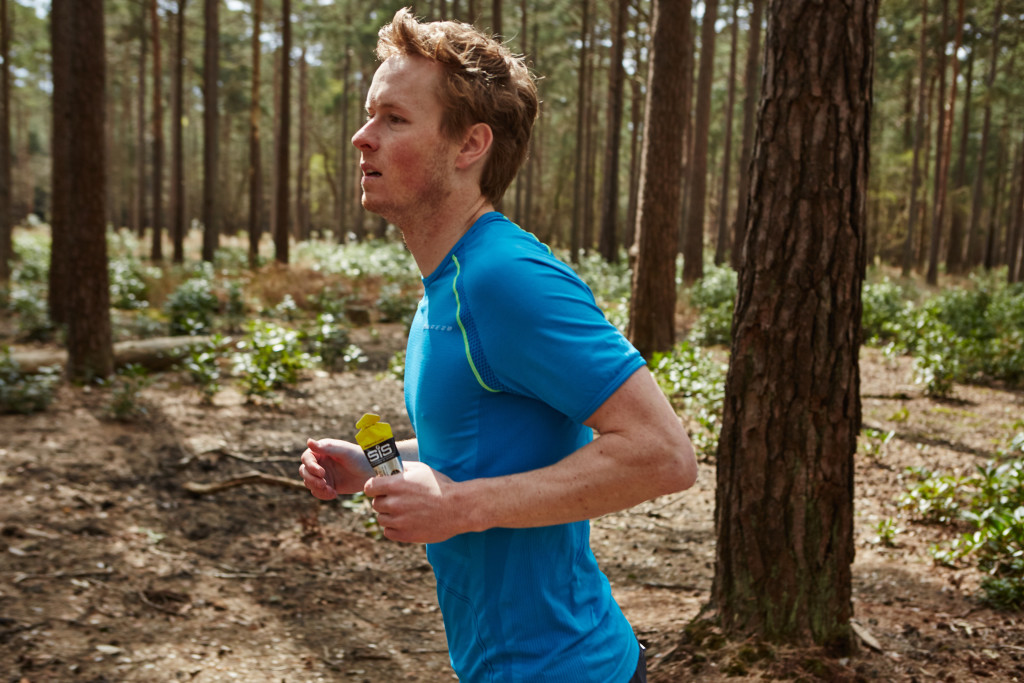
When you first make the move into middle to long distance running, the nutrition that you take on board is one of the many things that you’ll need to change. Some of these changes will be pretty straightforward – upping your calorie intake for example – but when it comes down to energy gels things get a little more complex.
Energy gels are one of the more bewildering elements of sports nutrition and given gels differ from “regular” food in pretty much every key way, it’s no wonder.
That’s why we’ve enlisted the help of Emma Baraclough, Senior Nutritionist for Science in Sport, to help us answer what makes a good energy gel, as well as why you might use them.
Why Use Gels?
Whole food sources such as energy bars and bananas are easy to take with you while on the move, but they’re not always the most suitable things to be eating. When you eat solid food, more blood flow gets diverted to your gut to help with digestion. This is fine when you are at rest, but when you are running and particularly at a higher intensity, you compromise the amount of blood flow that your working muscles receive. This makes you unable to either keep up the work rate, or you risk having the food sit heavily in your stomach waiting to be digested.
Gels, especially isotonic ones, empty quickly from your stomach and provide a fast source of energy. Most are purely carbohydrate, and unlike solid foods such as flapjacks and bananas, do not contain anything to slow the energy release down such as fat, protein or fibre.
What makes a good energy gel?
Not all energy gels are the same. They can vary a great deal in taste, energy content, other ingredients (such as electrolytes, caffeine) and thickness. All of these different characteristics mean that they behave very differently in the body and will be absorbed at different rates.
- Carbohydrate Source: The source of carbohydrate is really important. For a healthy balanced diet and sustained energy levels throughout a working day, we usually talk a lot about using low GI carbohydrates. These typically come from wholegrain food sources, and give a steady release into the bloodstream over a number of hours.
- High GI: During exercise the rapid demand for energy means that high GI carbohydrates are preferred. These are present much faster in the bloodstream and help you to keep up with the demands of your activity.
- Maltodextrin: Look out for this ingredient, it’s common in many gels and the reason you want it in your gel is that it’s a glucose polymer. This means that it is made up of chains of glucose molecules, and has a high GI, meaning that the energy is available quickly. Not all maltodextrin is the same however, the size of molecules can vary hugely. Ideally you need your gel to be made of a maltodextrin that empties quickly from your stomach and doesn’t create stomach issues. That’s why the maltodextrin we use in SiS GO Isotonic Energy Gels was chosen very carefully. Check the ingredients list, and look for maltodextrin as one of the first listed. In an isotonic gel water will be first on the list. Some gels may have a higher carbohydrate contents per serving, but they will not be isotonic.
- Fructose: is a common inclusion in many 2:1 energy gels. This is because it is absorbed via a different pathway to glucose, potentially increasing your carbohydrate intake from 60g maximum per hour to 90g per hour. The issue is what happens to the fructose once it is in your body, and how it can be turned into a fuel source that your muscles are able to use. This process takes some time, potentially as long as 90 minutes from when you ingest it to when it is able to enter your muscles and be converted into energy. Therefore it is not ideal to be reliant on fructose as a source of fast energy.
- Simple Sugars: Fructose and glucose are examples of simple sugars, which increase the concentration of a gel or drink, so you will need more water with it for it to be absorbed optimally. This can create an increased risk of causing GI distress, mainly for two potential reasons. Firstly if you don’t take enough water with your gel it will sit heavily in your stomach, as the emptying process will be delayed. Secondly, simple sugars feed the bacteria in the gut, this can result in more gas being produced which can cause bloating and cramps.
- Low Sugar: The key things to look for on the nutrition panel is the source of carbohydrate and check the “of which sugars” line. You should look for as little sugar as possible. The more sugar is listed there, the higher the tonicity will be, the more water you will need to take with it and the greater the risk will be of the gel causing you gastric distress.

Emma Barraclough is the Senior Sports Nutritionist for Science in Sport (SiS) www.scienceinsport.com






